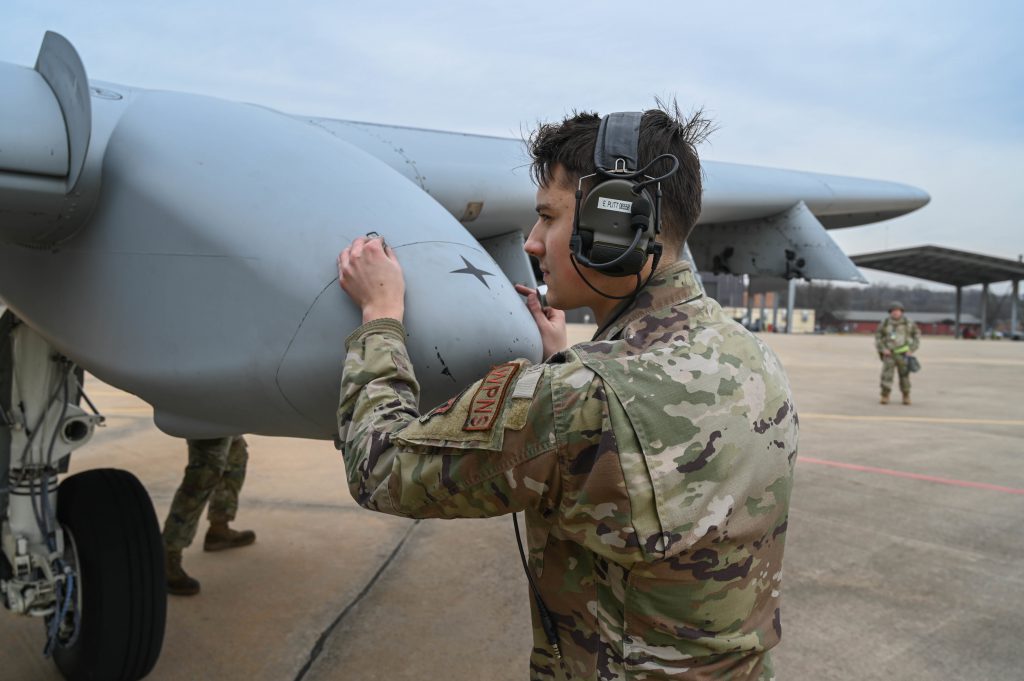Maryland Air Guard exercise skills to be ready for warfare
By Master Sgt. Chris Schepers

MARTIN STATE AIR NATIONAL GUARD BASE, Md. – The Maryland Air National Guard conducted a readiness exercise involving Airmen in a simulated deployed environment across Martin State Air National Guard Base from March 2-5.
The exercise, designated Operation Lucky Strike 2023, was built to test and demonstrate the 175th Wing’s ability to survive and operate in a near-peer conflict while executing unit-level critical tasks. All training activities were observed and monitored by unit subject matter experts and the inspector general’s office, which provided feedback to leaders and participants.
“Operation Lucky Strike is a full-scale readiness exercise designed to test our Airmen’s ability to ensure mission essential tasks are met in a contested, degraded, and operationally limited environment, to include chemical, biological, radiological and nuclear environments,” said Maryland Air National Guard Capt. Sara Nittinger, 175th Wing director of inspections. “Everything is driven by the new Air Force generation concept, AFFORGEN [Air Force Force Generation]. It is how we prepare our Airmen for deployments, where they have to be able to demonstrate that they can accomplish their core mission essential tasks in a variety of threat levels.”
During the exercise, wing Airmen had to operate during simulated cyberattacks, power outages, hazardous material accidents, force protection events, and severe weather. The exercise also took place at multiple locations, including Aberdeen Proving Ground and Ft. Meade, testing the wing’s ability to demonstrate agile combat employment, known as ACE.
“In the future, we could be operating in a hostile combat environment that is contested or degraded against an adversary that has peer capabilities – in other words, as capable as us and in some cases maybe more capable,” said Maryland Air National Guard Col. Richard Hunt, 175th Wing vice commander. “They are going to threaten us as much as we threaten them. In order for us to survive, operate, and be effective in a high-risk combat scenario, we need to have the ability to forward deploy to conduct combat operations for a very limited period of time with minimal exposure in the threat environment then move.”
Over the course of the four-day exercise, Airmen assigned to the 175th Maintenance Group and 175th Operations Group generated combat air power from home station and demonstrated their ability to conduct ACE from an austere location.

Throughout the exercise, maintenance Airmen and A-10 pilots performed integrated combat turns – commonly referred to as ICTs – and hot-pit refueling. ICTs are the simultaneous rearming and refueling of a running A-10C Thunderbolt II aircraft to reduce the aircrew’s ground time and quickly get them back in the air to execute missions.
“Practicing ICTs during an exercise helps prepare us for challenges, so when we deploy it is business as usual,” said Maryland Air National Guard Tech. Sgt. Anthony Johnson, avionics technician assigned to the 175th Aircraft Maintenance Squadron. “To successfully perform ACE, our teams need to be comprised of multi-capable Airmen. We want to taxi and park the A-10s in an austere location to re-arm and refuel them quickly with the smallest team possible so we can remain undetected then move.”
To help keep the A-10 mission moving forward in the cyber domain, Airmen from the 175th Cyberspace Operations Group worked with members of the Maryland Army National Guard’s 169th Cyber Protection Team to ensure the network that is used for flight operations remained uncompromised.
“The cyber team participating in the exercise are defending the forward operating base network that the A-10s are using to support flying operations,” said Maryland Air National Guard Maj. Stephanie Travis, weapons and tactics chief assigned to the 275th Cyberspace Operations Squadron. “We are providing mission assurance and protection to the networks that our teams would use for flying operations. We work in coordination with the communications squadron to make sure they [A-10 operations] can continue to fight the war and pursue the operations they are required to perform.”
To keep the training as close to what Airmen would encounter in a real-world deployment, Airmen from across the wing including leadership, civil engineers, medical, logistics, and numerous support functions performed their jobs while dealing with simulated attacks that required them to don protective equipment and take the steps necessary to ensure the environment was safe to operate within.
“This is a full-scale exercise, meaning we are exercising the entire base because we need to have every Airmen ready to perform their jobs,” said Hunt. “We are testing everybody because when we deploy, we all have to be able to complete our mission and potentially complete it in a non-typical work environment.”
At the conclusion of the exercise, the wing inspection team and wing inspector general’s office met with wing leadership to discuss the results of the exercise and lessons learned over the week-long exercise. The 175th Wing will now start to prepare for a mid-point inspection that will be evaulated by the Air Combat Command Inspector General Team.
“Our Airmen have done an outstanding job and I am so proud of how they have performed throughout the duration of this exercise. We have definitely stressed our Airmen and put a lot of pressure on them,” said Hunt. “They kept a positive attitude with a never give up mentality and had the ability to figure things out, make decisions, and move forward to be effective. So I could not be prouder with where we are at as a wing.”

